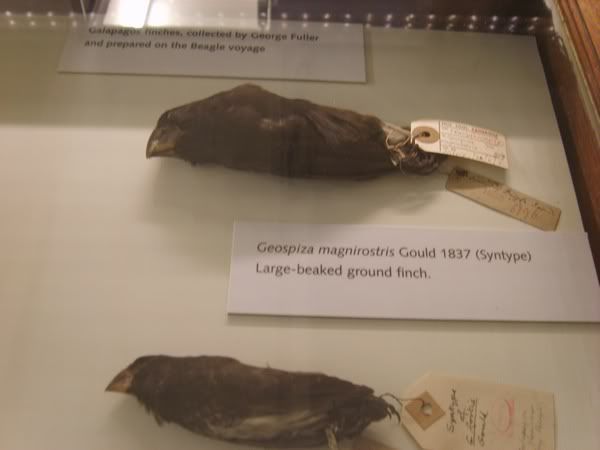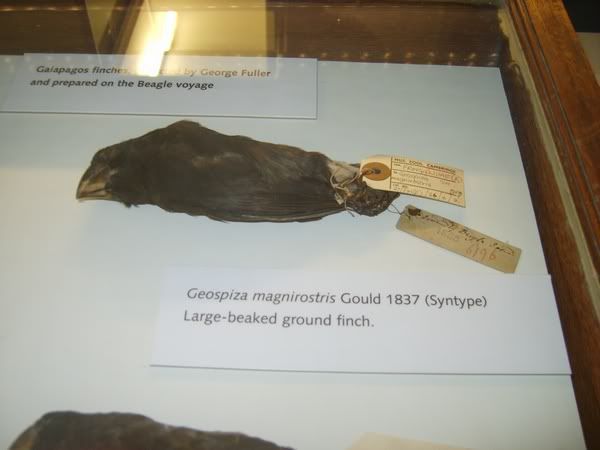|
|
Post by another specialist on Nov 5, 2009 22:49:30 GMT
The subspecies of the Large Ground-finch collected by Charles Darwin in 1835; he gave no precise locality. A similar bird was found in 1957, but no others have ever been seen.
wikipedia
|
|
|
|
Post by another specialist on Nov 5, 2009 22:51:19 GMT
University Museum of Zoology - Cambridge 5/11/09   |
|
|
|
Post by Peter on Aug 28, 2014 15:54:59 GMT
Is this subspecies still valid? Hume & Walters (2012) still mention the extinct 'subspecies' Geospiza magnirostris magnirostris and the extant 'subspecies' Geospiza magnirostris strenua. However, all other sources I can find don't recognise subspecies and therefore don't consider it extinct, like: - Clements, J. F., T. S. Schulenberg, M. J. Iliff, B.L. Sullivan, C. L. Wood, and D. Roberson. (2013). The eBird/Clements checklist of birds of the world: Version 6.8. Downloaded from www.birds.cornell.edu/clementschecklist/download/
- Gill, F. & D. Donsker (Eds). (2014). IOC World Bird List (v 4.2). doi : 10.14344/IOC.ML.4.2.
. |
|
|
|
Post by Melanie on Aug 28, 2014 18:10:24 GMT
|
|
|
|
Post by surroundx on Aug 30, 2014 3:24:50 GMT
If it is the nominate which is considered extinct, with another subspecies extant, and then they are synonymized then the nominate should be considered rediscovered in my opinion.
|
|
|
|
Post by surroundx on Aug 30, 2014 3:42:10 GMT
All other sources I can find don't recognise subspecies and therefore don't consider it extinct... In his classic paper on Darwin's finches, Frank J. Sulloway recognized their subspecific status, although what authority he is seen to have in these matters I don't know: Sulloway, Frank J. (1982). Darwin and His Finches: The Evolution of a Legend. Journal of the History of Biology 15(1): 1-53. But you probably mean up to date taxonomic authorities (i.e. 2010 or later)? Although I would be interested to know if you know of any pre-2010 sources like Sulloway. I always like to be thorough  EDIT: I've just read the account in Hume & Walters (2012), and there is more information on the nominate than I thought, including the Sulloway reference and other historical references. Thanks anyway, Peter  |
|
|
|
Post by Melanie on Aug 30, 2014 15:01:22 GMT
|
|
|
|
Post by Peter on Aug 31, 2014 8:43:27 GMT
Thanks Melanie and Branden! As the two subspecies characteristics did overlap, they were indeed probable not distinct. I'll keep an eye on the Birdforum.net discussion.
|
|
|
|
Post by Melanie on Aug 31, 2014 12:47:38 GMT
I think it is prematured to say whether this taxon is invalid or not. Further studies are necessary to make a clear statement about its status. There are several bird taxa on Galapagos (e.g. the likewise extinct San Christobal Vermillion fly-catcher) where you can say the same (which will mean that there are other Vermillion fly-catchers on Galapagos which are very similar). Hume & Waters gave a good account about Darwin's Large Ground-finch and I am currently thinking to move this thread back to extinct.
|
|
|
|
Post by Peter on Sept 1, 2014 20:29:03 GMT
Well, the new bird checklists (HBW; Gill & Donsker 2014; Lepage & Warnier 2014; Clements et al. 2013) doesn't recognise G. m. strenua as valid. The same with the recent paper by McKay and Zink (2014). I think most recent sources agree that Geospiza magnirostris is monotypic and still extant. That is already a clear statement about its status in my opinion.
Hume & Walters (2012) say that it was a valid now-extinct taxon (Geospiza magnirostris magnirostris), based on that Darwin's Large Ground Finches once occurred on Floreana and San Cristóbal. However, it also say that a bird caught by Bowman on Floreana in 1957 (others were seen) was morphologically more similar to G. m. strenua. They conclude that Bowman had encountered a small population of G. m. strenua that recently colonised the island. And that this population also became extinct. To me, this means that the different populations could reach the other islands and thus that there could have been also transfer of their genetics. This would also mean that there the populations were not isolated and it would thus be very unlikely that different subspecies could develop.
|
|
|
|
Post by surroundx on May 4, 2015 4:27:57 GMT
|
|